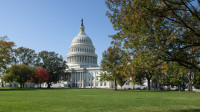
In This Article
- How federal funding props up red states—and why they need it.
- What happens when the GOP guts federal transfers?
- Why cities are already struggling—and states are next.
- Will blue states keep subsidizing red-state failures?
- What does economic secession look like?
Why America Will Go Broke
by Robert Jennings, InnerSelf.comHere’s something that might shock the average Fox News viewer: red states are the biggest welfare queens in America. They take far more from the federal government than they contribute, all while railing against "socialist handouts." Mississippi, Kentucky, and West Virginia are practically on financial life support, kept alive by federal transfers. But now, the very people running the show—Trump, Doge, and their Republican allies—are trying to end those federal lifelines.
For decades, the economic imbalance between red and blue states has been papered over by federal grants, Medicaid dollars, and infrastructure investments. But if the new GOP leadership has its way, those funds will dry up—leading to a fiscal reckoning that will hit red states hardest.
Taker States
Taker states receive more in federal funding than they contribute in federal taxes, meaning they rely on federal money to sustain their budgets. These states are mostly concentrated in the South, Midwest, and rural West, including Alabama, Alaska, Arizona, Arkansas, Kentucky, Louisiana, Mississippi, Missouri, Montana, New Mexico, North Dakota, South Carolina, South Dakota, Tennessee, West Virginia, and Wyoming. These states typically have lower wages, higher poverty rates, and weaker tax bases, making them dependent on federal transfers for crucial services like healthcare, education, and infrastructure. Many have also enacted low-tax, small-government policies, which leave them even more vulnerable when federal funds are cut.
The irony is that the same politicians in these states who push for gutting federal spending are jeopardizing their own economies. Without these federal lifelines, taker states would face severe budget shortfalls, service cutbacks, and possible economic collapse as they struggle to replace lost federal dollars.
Historically, the economies of many taker states have been extractive in nature, relying on industries such as agriculture, mining, and manufacturing, which have not adapted well to a modern, service-based economy. Additionally, the refusal to invest in public education and infrastructure has left these states less competitive in attracting high-paying industries. This structural weakness makes them even more reliant on federal support, despite their political leadership’s opposition to it.
Giver States
Giver states pay more in federal taxes than they receive in federal funding, meaning they are the ones subsidizing the taker states. These states, often with stronger economies and higher-income populations, include California, Colorado, Connecticut, Delaware, Florida, Georgia, Hawaii, Idaho, Illinois, Indiana, Iowa, Kansas, Maine, Maryland, Massachusetts, Michigan, Minnesota, Nebraska, Nevada, New Hampshire, New Jersey, New York, North Carolina, Ohio, Oklahoma, Oregon, Pennsylvania, Rhode Island, Texas, Utah, Vermont, Virginia, Washington, and Wisconsin.
These states generate large tax revenues through robust industries, high-wage jobs, and business hubs, yet they receive disproportionately less federal funding in return. If the federal government continues to shrink spending and cut transfers, the biggest question is how long these states will tolerate footing the bill for states that refuse to invest in their own economic sustainability. If giver states ever stopped subsidizing the takers, many red-state economies would collapse under their own weight—a reality that politicians refuse to acknowledge while railing against the very federal government that keeps them afloat.
Unlike taker states, many giver states have made long-term investments in education, technology, and infrastructure, which have allowed their economies to remain competitive and prosperous. These states tend to have a larger share of high-wage service jobs, major financial centers, and tech hubs that generate significant tax revenue. Yet, despite their fiscal responsibility, they continue to subsidize states that refuse to modernize their economies.
Cities Are Already in Trouble
If you think this is just a red-state problem, think again. America’s cities—especially those with already strained budgets—are next in line for collapse. The pandemic reshaped urban economies, and many cities haven’t recovered. More remote work means fewer people commuting, which means less revenue from businesses, sales taxes, and transit fares. And then there’s the pension crisis—decades of underfunding and financial mismanagement are now coming home to roost.
Take Chicago, for example. The city faces nearly $35 billion in unfunded pension liabilities. Houston’s flood-related infrastructure costs are expected to add another $300 million to its deficit. San Francisco’s once-booming downtown is a ghost town, thanks to a commercial real estate collapse.
And the one thing keeping cities from total financial ruin? You guessed it—federal funds. But if the GOP gets its way, those funds are on the chopping block.
The Next Domino to Fall
While cities face immediate fiscal pain, state governments aren’t far behind. Red states have long avoided raising taxes, relying instead on federal support to balance their budgets. That strategy worked when Uncle Sam was footing the bill. But what happens when those federal dollars disappear?
Republican-controlled states like Texas and Florida love to brag about their low taxes and "fiscally conservative" policies. What they don’t mention is that they’ve built their budgets on federal transfers. When those funds dry up, states will be forced to choose: raise taxes or cut essential services.
Here’s a prediction: they’ll choose cuts. Education? Slashed. Healthcare? Privatized. Infrastructure? Left to crumble. And when that happens, people will leave—just like they did in Kansas when Sam Brownback’s tax-cutting experiment turned the state into an economic disaster zone.
The Federal Government Advantage
There’s one fundamental truth that most politicians—and even some economists—conveniently ignore: the federal government is not like a state or city when it comes to money. Unlike states, which must balance their budgets through taxation or borrowing, the federal government has the sole authority to create money. This is the core reason why it can afford massive expenditures, whether for infrastructure, social programs, or military spending, without “running out” of dollars.
States and cities, on the other hand, are financially constrained. They must raise revenue through taxes, fees, or bonds. If they fall short, they can’t just print their way out of a deficit—they have to cut spending, raise taxes, or borrow at high interest rates. That’s why federal transfers are essential: they fill in the gaps where local tax revenue falls short.
Take a state like Mississippi, which receives more than 40% of its budget from federal transfers. If those funds were suddenly cut, the state wouldn’t have the option to print money to make up the difference—it would be forced into severe austerity. That means gutting public schools, slashing healthcare programs, and letting roads and bridges fall into further disrepair.
Federal funding acts as the economic glue that keeps states—especially red states—functioning. When Republicans talk about “cutting spending,” they aren’t talking about cutting corporate tax breaks or military contracts. They’re talking about cutting the very lifeline that keeps their own voters afloat. And since states can’t print their own money, they will either collapse financially or be forced to beg for bailouts from the same federal government they claim to hate.
Ironically, the very people pushing to shrink the federal government—Trump, Doge, and their allies—are the ones most dependent on it. Without federal spending, red states wouldn’t just struggle; many would cease to function altogether. And the kicker? The federal government doesn’t actually need to “cut spending” to remain solvent—it only does so as a political choice, not an economic necessity.
Land of The Wealthy, and Low Taxes
It’s no secret that the United States leads the world in wealth concentration. Among developed nations, the U.S. has the highest level of income inequality, with the top 1% controlling over 40% of the nation's wealth—far more than in any other OECD country. But the wealth gap isn’t just about the ultra-rich hoarding assets; it’s about how deeply ingrained inequality has become in the American economy.
One glaring example is the number of billionaires. As of 2024, the United States has approximately 813 billionaires, more than any other country. While China, including Hong Kong, has slightly more at 814 billionaires, the U.S. still dominates in per capita terms, with a far higher density of billionaires relative to its population. Europe as a whole has around 573 billionaires, lagging behind both the U.S. and China. This overwhelming concentration of wealth in America shows that while economic opportunities exist, they overwhelmingly benefit the ultra-rich rather than the working and middle classes.
But the billionaire class is just the tip of the iceberg. The United States is also home to the largest number of millionaires in the world—approximately 21.95 million as of 2024. This means that about 8.5% of American adults have a net worth exceeding $1 million. In comparison, China has around 6.01 million millionaires, which is only about 0.6% of its adult population. Europe collectively accounts for 16.7 million millionaires, but spread across multiple countries with varying levels of wealth concentration. While Switzerland has an extremely high percentage of millionaires relative to its small population, no individual country in Europe surpasses the U.S. in sheer numbers or density.
What makes this extreme wealth concentration even more striking is that the United States is one of the least taxed major economies. In 2021, total U.S. tax revenue accounted for just 27% of GDP, compared to the 34% OECD average. Many European countries, where wealth inequality is far lower, collect over 40% of GDP in taxes to fund social programs, healthcare, and infrastructure. The U.S. tax system also leans heavily on income and corporate taxes, while relying far less on consumption taxes, such as VAT (Value-Added Tax), which are common in Europe.
This combination—a vast number of ultra-wealthy individuals and a tax system that allows them to keep more of their wealth—further fuels inequality. Unlike in other developed nations, where high tax rates help redistribute wealth and fund public services, America’s tax policies allow billionaires and millionaires to accumulate wealth at unprecedented levels while middle-class and working-class Americans shoulder a disproportionate tax burden. The myth of the “self-made millionaire” persists, but the data paints a different picture—one where economic mobility is declining, and the benefits of growth are increasingly hoarded by a small fraction of the population. As economic inequality continues to widen, the question remains: how sustainable is a system where an overwhelming share of wealth is concentrated at the top while millions struggle to afford basic necessities?
Poverty in America: A Stark Contrast Among States
The United States, often hailed as a land of opportunity, paradoxically exhibits some of the highest poverty rates among developed nations. According to the Organization for Economic Cooperation and Development (OECD), the U.S. leads with a poverty rate of approximately 18%, significantly surpassing the average of other developed countries. This disparity raises critical questions about the effectiveness of America's social safety nets and economic policies.
Delving deeper, a pronounced divide emerges between states traditionally labeled as "red" (Republican-leaning) and "blue" (Democratic-leaning). Data indicates that red states generally experience higher poverty rates compared to their blue counterparts. For instance, Mississippi and Louisiana, both red states, report poverty rates among the highest in the nation. In contrast, blue states like New Hampshire and Maryland have notably lower poverty rates. This contrast suggests that state-level policies and governance play a pivotal role in influencing economic well-being.
Several factors contribute to these disparities. Red states often implement more restrictive social welfare programs and have lower minimum wages, which can limit economic mobility and access to essential services. Conversely, blue states typically invest more in public services, education, and healthcare, providing a more robust support system for their residents. This investment correlates with lower poverty rates and improved quality of life indicators.
Understanding these distinctions is crucial for policymakers and citizens alike. Addressing poverty requires a nuanced approach that considers the unique economic landscapes and policy decisions of each state. By analyzing and learning from the successes and challenges across this spectrum, there lies potential to develop more effective strategies to combat poverty nationwide.
Will Blue States Keep Subsidizing Red States?
Historically, blue states have been the financial backbone of America, subsidizing the less productive red states. California, New York, and Illinois send far more in tax dollars to Washington than they receive. Meanwhile, states like Alabama and Mississippi are essentially on welfare.
But with federal finances imploding, will blue states continue to support the states that have spent decades undermining them? The answer might be a resounding no.
If red states refuse to tax their wealthy, refuse to invest in their own people, and refuse to contribute their fair share, why should blue states keep bailing them out?
The Inevitable Consequence?
When a financial system collapses, something has to give. If the GOP's fiscal policies push America into economic chaos, we may see a form of economic secession before political secession.
Blue states, tired of funding red-state dysfunction, may start looking for ways to keep their tax dollars closer to home. This could mean new regional economic alliances, pushing for greater autonomy from Washington, or outright resistance to federal budget cuts.
Meanwhile, red states—deprived of the federal money that keeps them afloat—could find themselves in a downward spiral of cuts, job losses, and population decline.
America is Eating Itself
For all their talk about "fiscal responsibility," Republicans have engineered an economic catastrophe. By starving cities and states of federal support, they are setting the stage for widespread financial ruin. And the cruel irony? Their own voters will suffer the most.
The great American economic divide is about to get even deeper. And when the bill comes due, the question won't be whether America can afford to bail out red states—it’ll be whether blue states even want to.
In many ways, this divide is not new but a continuation of a long-standing economic and political schism that has defined the country since its inception. The Southern states, which historically relied on an extractive, neo-feudal economy built on slavery and later sharecropping, were forcibly reintegrated into the Union after the Civil War. But what if Abraham Lincoln had let them go their own way? Would the rest of the nation have been better off if the North had not been burdened with subsidizing an economy resistant to modernization and social progress?
Or consider the compromise of 1876, which effectively ended Reconstruction and allowed the South to revert to a system that, while no longer based on slavery, still entrenched economic and racial hierarchies that persist to this day. The Republican Party of that era, prioritizing political expediency, abandoned newly freed Black citizens and progressive economic reforms in exchange for Southern electoral votes. That fateful decision enabled the continuation of an economic system that has remained dependent on low-wage labor, limited public investment, and federal subsidies. The very states that benefited from these compromises are the same ones now demanding the dismantling of the federal government, without realizing they are signing their own economic death warrant.
The irony of this trajectory is that while the South was forced back into the Union, it has remained economically dependent on federal support for over a century. Would America be stronger today if the South had remained independent? Would the country have been better served if the federal government had continued Reconstruction policies instead of allowing the South to return to a quasi-feudal economic system? These are uncomfortable questions, but they are central to understanding the modern economic divide.
Welcome to the new America, where economic survival depends on geography, politics, and who’s in power. If this is the road Trump, Doge, and the GOP want to take, they may soon find themselves leading a nation that’s too broke to function.
About the Author
 Robert Jennings is the co-publisher of InnerSelf.com, a platform dedicated to empowering individuals and fostering a more connected, equitable world. A veteran of the U.S. Marine Corps and the U.S. Army, Robert draws on his diverse life experiences, from working in real estate and construction to building InnerSelf with his wife, Marie T. Russell, to bring a practical, grounded perspective to life’s challenges. Founded in 1996, InnerSelf.com shares insights to help people make informed, meaningful choices for themselves and the planet. More than 30 years later, InnerSelf continues to inspire clarity and empowerment.
Robert Jennings is the co-publisher of InnerSelf.com, a platform dedicated to empowering individuals and fostering a more connected, equitable world. A veteran of the U.S. Marine Corps and the U.S. Army, Robert draws on his diverse life experiences, from working in real estate and construction to building InnerSelf with his wife, Marie T. Russell, to bring a practical, grounded perspective to life’s challenges. Founded in 1996, InnerSelf.com shares insights to help people make informed, meaningful choices for themselves and the planet. More than 30 years later, InnerSelf continues to inspire clarity and empowerment.
Creative Commons 4.0
This article is licensed under a Creative Commons Attribution-Share Alike 4.0 License. Attribute the author Robert Jennings, InnerSelf.com. Link back to the article This article originally appeared on InnerSelf.com
Recommended books:
Capital in the Twenty-First Century
by Thomas Piketty. (Translated by Arthur Goldhammer)
 In Capital in the Twenty-First Century, Thomas Piketty analyzes a unique collection of data from twenty countries, ranging as far back as the eighteenth century, to uncover key economic and social patterns. But economic trends are not acts of God. Political action has curbed dangerous inequalities in the past, says Thomas Piketty, and may do so again. A work of extraordinary ambition, originality, and rigor, Capital in the Twenty-First Century reorients our understanding of economic history and confronts us with sobering lessons for today. His findings will transform debate and set the agenda for the next generation of thought about wealth and inequality.
In Capital in the Twenty-First Century, Thomas Piketty analyzes a unique collection of data from twenty countries, ranging as far back as the eighteenth century, to uncover key economic and social patterns. But economic trends are not acts of God. Political action has curbed dangerous inequalities in the past, says Thomas Piketty, and may do so again. A work of extraordinary ambition, originality, and rigor, Capital in the Twenty-First Century reorients our understanding of economic history and confronts us with sobering lessons for today. His findings will transform debate and set the agenda for the next generation of thought about wealth and inequality.
Click here for more info and/or to order this book on Amazon.
Nature's Fortune: How Business and Society Thrive by Investing in Nature
by Mark R. Tercek and Jonathan S. Adams.
 What is nature worth? The answer to this question—which traditionally has been framed in environmental terms—is revolutionizing the way we do business. In Nature’s Fortune, Mark Tercek, CEO of The Nature Conservancy and former investment banker, and science writer Jonathan Adams argue that nature is not only the foundation of human well-being, but also the smartest commercial investment any business or government can make. The forests, floodplains, and oyster reefs often seen simply as raw materials or as obstacles to be cleared in the name of progress are, in fact as important to our future prosperity as technology or law or business innovation. Nature’s Fortune offers an essential guide to the world’s economic—and environmental—well-being.
What is nature worth? The answer to this question—which traditionally has been framed in environmental terms—is revolutionizing the way we do business. In Nature’s Fortune, Mark Tercek, CEO of The Nature Conservancy and former investment banker, and science writer Jonathan Adams argue that nature is not only the foundation of human well-being, but also the smartest commercial investment any business or government can make. The forests, floodplains, and oyster reefs often seen simply as raw materials or as obstacles to be cleared in the name of progress are, in fact as important to our future prosperity as technology or law or business innovation. Nature’s Fortune offers an essential guide to the world’s economic—and environmental—well-being.
Click here for more info and/or to order this book on Amazon.
Beyond Outrage: What has gone wrong with our economy and our democracy, and how to fix it -- by Robert B. Reich
 In this timely book, Robert B. Reich argues that nothing good happens in Washington unless citizens are energized and organized to make sure Washington acts in the public good. The first step is to see the big picture. Beyond Outrage connects the dots, showing why the increasing share of income and wealth going to the top has hobbled jobs and growth for everyone else, undermining our democracy; caused Americans to become increasingly cynical about public life; and turned many Americans against one another. He also explains why the proposals of the “regressive right” are dead wrong and provides a clear roadmap of what must be done instead. Here’s a plan for action for everyone who cares about the future of America.
In this timely book, Robert B. Reich argues that nothing good happens in Washington unless citizens are energized and organized to make sure Washington acts in the public good. The first step is to see the big picture. Beyond Outrage connects the dots, showing why the increasing share of income and wealth going to the top has hobbled jobs and growth for everyone else, undermining our democracy; caused Americans to become increasingly cynical about public life; and turned many Americans against one another. He also explains why the proposals of the “regressive right” are dead wrong and provides a clear roadmap of what must be done instead. Here’s a plan for action for everyone who cares about the future of America.
Click here for more info or to order this book on Amazon.
This Changes Everything: Occupy Wall Street and the 99% Movement
by Sarah van Gelder and staff of YES! Magazine.
 This Changes Everything shows how the Occupy movement is shifting the way people view themselves and the world, the kind of society they believe is possible, and their own involvement in creating a society that works for the 99% rather than just the 1%. Attempts to pigeonhole this decentralized, fast-evolving movement have led to confusion and misperception. In this volume, the editors of YES! Magazine bring together voices from inside and outside the protests to convey the issues, possibilities, and personalities associated with the Occupy Wall Street movement. This book features contributions from Naomi Klein, David Korten, Rebecca Solnit, Ralph Nader, and others, as well as Occupy activists who were there from the beginning.
This Changes Everything shows how the Occupy movement is shifting the way people view themselves and the world, the kind of society they believe is possible, and their own involvement in creating a society that works for the 99% rather than just the 1%. Attempts to pigeonhole this decentralized, fast-evolving movement have led to confusion and misperception. In this volume, the editors of YES! Magazine bring together voices from inside and outside the protests to convey the issues, possibilities, and personalities associated with the Occupy Wall Street movement. This book features contributions from Naomi Klein, David Korten, Rebecca Solnit, Ralph Nader, and others, as well as Occupy activists who were there from the beginning.
Click here for more info and/or to order this book on Amazon.
Article Recap
Federal funding cuts are triggering a financial crisis in red states, exposing their long-standing dependency on federal aid. Cities are already struggling, and states are next in line as Republican-led policies gut federal transfers. With blue states historically subsidizing red-state economies, the big question remains: will they continue to do so? As economic pressures mount, America may be heading toward financial collapse, with the GOP’s policies accelerating the decline.
#FederalFundingCuts #RedStatesCrisis #EconomicDecline #StateEconomies #FinancialInstability








